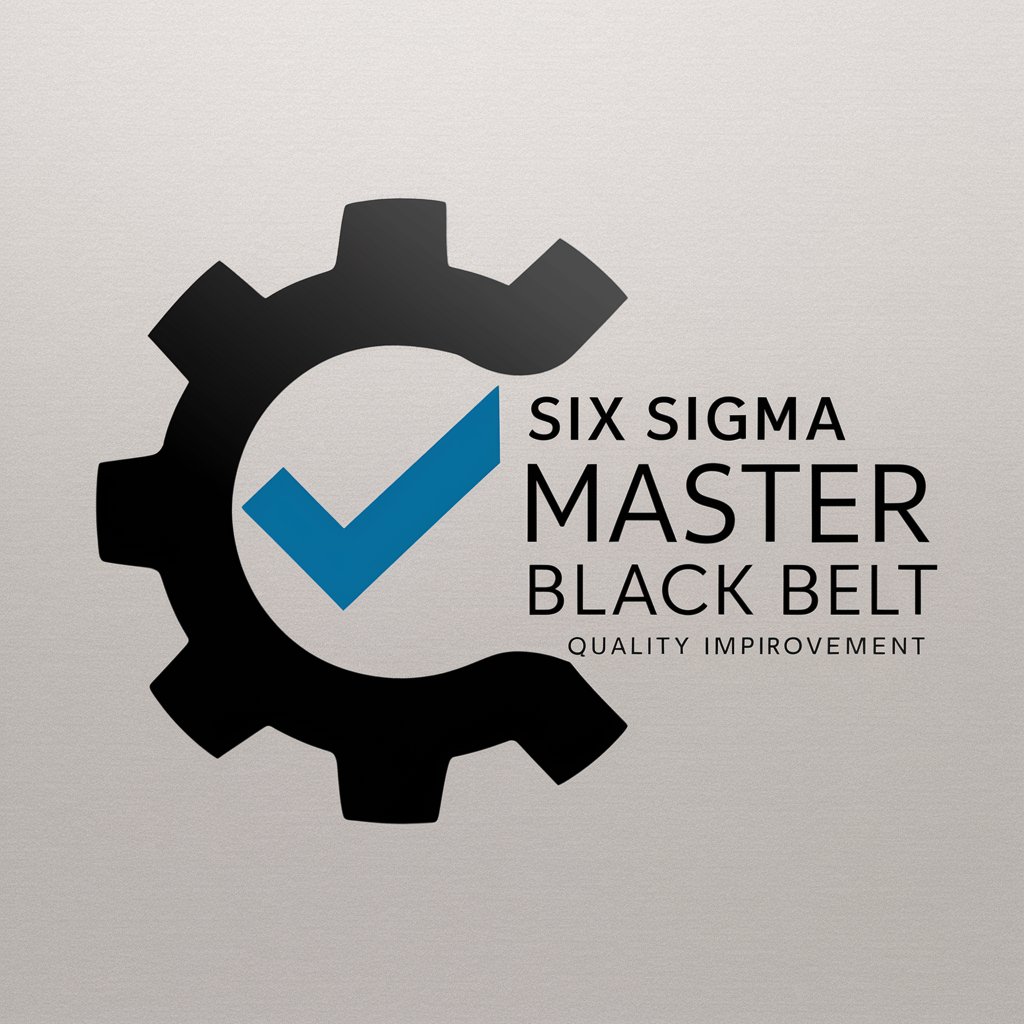Six Sigma Master Black Belt - Six Sigma Guidance

Welcome to the Six Sigma Master Black Belt guidance.
Empowering Excellence with AI
Generate a detailed process map for optimizing...
Create a Pareto chart to identify key areas of improvement in...
Develop a control plan to sustain changes in the...
Analyze the root causes of defects using a cause-and-effect diagram for...
Get Embed Code
Introduction to Six Sigma Master Black Belt
The Six Sigma Master Black Belt (SSMBB) represents the highest level of expertise and knowledge in the Six Sigma methodology. Designed as a key driver for implementing Six Sigma projects within organizations, the SSMBB is responsible for high-level project management, strategic implementation, and mentoring of Green and Black Belts. They are experts in statistical analysis, project management, and process improvement methodologies, ensuring that Six Sigma projects align with organizational goals. For example, in a manufacturing setting, a Master Black Belt might oversee the optimization of a production line to reduce defects to a negligible rate, illustrating their role in leading complex projects that require a deep understanding of both Six Sigma methodologies and business operations. Powered by ChatGPT-4o。

Main Functions of Six Sigma Master Black Belt
Strategic Project Leadership
Example
Leading the integration of Six Sigma into the company's strategic objectives
Scenario
In a large corporation, the Master Black Belt develops a strategic plan to apply Six Sigma methodologies across various departments, aligning Six Sigma projects with the company’s long-term goals for quality improvement and cost reduction.
Mentoring and Coaching
Example
Guiding Green and Black Belts through the DMAIC process
Scenario
A Master Black Belt mentors a team of Black Belts working on reducing cycle time in a call center, providing expertise in statistical analysis and project management to ensure successful project completion.
Advanced Statistical Analysis
Example
Applying complex statistical methods to analyze process data
Scenario
In a pharmaceutical company, the Master Black Belt uses advanced statistical analysis to identify root causes of variations in drug purity levels, leading to significant improvements in product quality.
Training and Development
Example
Conducting workshops and training sessions for Six Sigma methodologies
Scenario
The Master Black Belt organizes and leads a series of workshops aimed at training new Green Belts on the DMAIC process, tools, and techniques, ensuring a consistent approach to process improvement within the organization.
Ideal Users of Six Sigma Master Black Belt Services
Corporate Executives
Senior management and decision-makers in corporations who seek to embed quality improvement and operational excellence into their organizational culture would benefit significantly. They rely on SSMBBs to lead strategic initiatives that drive efficiency, reduce costs, and improve quality across the board.
Quality Managers
Individuals responsible for overseeing quality control and assurance within organizations. They benefit from the expertise of SSMBBs in identifying, planning, and executing projects that directly impact product quality and customer satisfaction.
Process Improvement Teams
Teams tasked with the ongoing improvement of operational processes. SSMBBs provide these teams with high-level guidance, advanced statistical analysis skills, and mentorship to tackle complex improvement projects effectively.
SME Owners
Owners of small and medium-sized enterprises looking to optimize their operations without the resources of larger corporations. SSMBBs can offer tailored advice and strategies to implement lean processes and improve efficiency on a smaller scale.

Using Six Sigma Master Black Belt
Initiate your Six Sigma journey
Begin by exploring yeschat.ai for an introductory trial, offering immediate access without the necessity of account creation or subscription to ChatGPT Plus.
Identify your project scope
Clearly define the problem or improvement area within your organization that you aim to address using Six Sigma methodologies.
Gather data
Collect relevant data pertaining to the defined problem area. This may involve quantitative data collection or process observations to understand current performance.
Analyze and apply tools
Utilize Six Sigma tools and techniques such as DMAIC (Define, Measure, Analyze, Improve, Control) to analyze the collected data and identify root causes of inefficiencies.
Implement improvements
Based on your analysis, develop and implement solutions to address the root causes. Monitor the results and make necessary adjustments to ensure sustained improvements.
Try other advanced and practical GPTs
Mungerism
Empowering In-Depth Insights with AI

Mindset Mentor
Empower Your Success with AI

Summarizer
AI-powered insights on Indian companies

いいやつ
Empowering Communication with AI Kindness

El Kekos GPT, Malaisologue
Unleashing the humor in awkwardness with AI.

IAS GPT
Tailored UPSC Prep with AI

The Smell of Iron: Rise of the Eiffel Tower
Build the Eiffel, Shape History

Air Traffic Controller
Master the skies with AI-powered ATC

Potluck Planner
Streamlining Potlucks with AI Smarts

Martini Mixer Master
AI-powered Martini Crafting Assistant

Elgato
Empower Your Creativity with AI

Marionette
Empower Creativity with AI

FAQs on Six Sigma Master Black Belt
What is Six Sigma Master Black Belt?
A Six Sigma Master Black Belt represents the highest level of expertise in the Six Sigma methodology, focusing on strategic implementation, training, and mentoring within an organization to drive process improvements and operational excellence.
How can Six Sigma Master Black Belt benefit my organization?
By implementing Six Sigma Master Black Belt practices, organizations can achieve significant improvements in process efficiency, reduce operational costs, enhance product quality, and increase customer satisfaction through data-driven decision making and continuous improvement practices.
What prerequisites are needed to utilize Six Sigma Master Black Belt effectively?
Prerequisites include a solid understanding of Six Sigma principles, completion of Green Belt and Black Belt certifications, and substantial experience in leading and managing improvement projects.
Can Six Sigma Master Black Belt be applied to any industry?
Yes, Six Sigma Master Black Belt methodologies are versatile and can be applied across various industries including manufacturing, healthcare, finance, and technology to improve processes and eliminate defects.
What are common tools used by Six Sigma Master Black Belts?
Common tools include statistical analysis software, process mapping, root cause analysis techniques like Fishbone diagrams and 5 Whys, and project management tools to oversee improvement initiatives.
